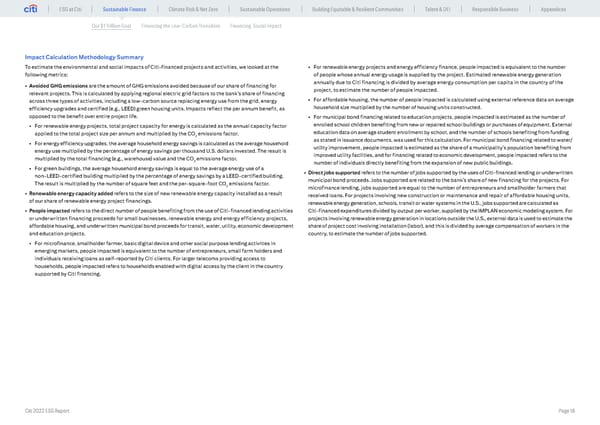ESG at Citi Sustainable Finance Climate Risk & Net Zero Sustainable Operations Building Equitable & Resilient Communities Talent & DEI Responsible Business Appendices Our $1 Trillion Goal Financing the Low-Carbon Transition Financing Social Impact Impact Calculation Methodology Summary To estimate the environmental and social impacts of Citi-financed projects and activities, we looked at the • For renewable energy projects and energy efficiency finance, people impacted is equivalent to the number following metrics: of people whose annual energy usage is supplied by the project. Estimated renewable energy generation • Avoided GHG emissions are the amount of GHG emissions avoided because of our share of financing for annually due to Citi financing is divided by average energy consumption per capita in the country of the relevant projects. This is calculated by applying regional electric grid factors to the bank’s share of financing project, to estimate the number of people impacted. across three types of activities, including a low-carbon source replacing energy use from the grid, energy • For affordable housing, the number of people impacted is calculated using external reference data on average efficiency upgrades and certified (e.g., LEED) green housing units. Impacts reflect the per annum benefit, as household size multiplied by the number of housing units constructed. opposed to the benefit over entire project life. • For municipal bond financing related to education projects, people impacted is estimated as the number of • For renewable energy projects, total project capacity for energy is calculated as the annual capacity factor enrolled school children benefiting from new or repaired school buildings or purchases of equipment. External applied to the total project size per annum and multiplied by the CO emissions factor. education data on average student enrollment by school, and the number of schools benefiting from funding 2 as stated in issuance documents, was used for this calculation. For municipal bond financing related to water/ • For energy efficiency upgrades, the average household energy savings is calculated as the average household utility improvement, people impacted is estimated as the share of a municipality’s population benefiting from energy use multiplied by the percentage of energy savings per thousand U.S. dollars invested. The result is improved utility facilities, and for financing related to economic development, people impacted refers to the multiplied by the total financing (e.g., warehouse) value and the CO2 emissions factor. number of individuals directly benefiting from the expansion of new public buildings. • For green buildings, the average household energy savings is equal to the average energy use of a • Direct jobs supported refers to the number of jobs supported by the uses of Citi-financed lending or underwritten non-LEED-certified building multiplied by the percentage of energy savings by a LEED-certified building. municipal bond proceeds. Jobs supported are related to the bank’s share of new financing for the projects. For The result is multiplied by the number of square feet and the per-square-foot CO2 emissions factor. microfinance lending, jobs supported are equal to the number of entrepreneurs and smallholder farmers that • Renewable energy capacity added refers to the size of new renewable energy capacity installed as a result received loans. For projects involving new construction or maintenance and repair of affordable housing units, of our share of renewable energy project financings. renewable energy generation, schools, transit or water systems in the U.S., jobs supported are calculated as • People impacted refers to the direct number of people benefiting from the use of Citi-financed lending activities Citi-financed expenditures divided by output per worker, supplied by the IMPLAN economic modeling system. For or underwritten financing proceeds for small businesses, renewable energy and energy efficiency projects, projects involving renewable energy generation in locations outside the U.S., external data is used to estimate the affordable housing, and underwritten municipal bond proceeds for transit, water, utility, economic development share of project cost involving installation (labor), and this is divided by average compensation of workers in the and education projects. country, to estimate the number of jobs supported. • For microfinance, smallholder farmer, basic digital device and other social purpose lending activities in emerging markets, people impacted is equivalent to the number of entrepreneurs, small farm holders and individuals receiving loans as self-reported by Citi clients. For larger telecoms providing access to households, people impacted refers to households enabled with digital access by the client in the country supported by Citi financing. Citi 2022 ESG Report Page 16
 Global ESG Report 2022 Citi Bookmarked Page 15 Page 17
Global ESG Report 2022 Citi Bookmarked Page 15 Page 17